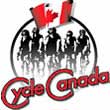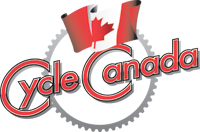Cycle Canada Blog
Shipping a Bike
by Bud Jorgensen
On all of Cycle Canada trips, we have space in the trucks to store bike boxes for re-use at the end of the ride. We can handle soft-shell commercial cases, if they fold flat. But we don't have space for hard-shell cases.
These tips by Bud Jorgensen, founder of Tour du Canada and owner/operator of Cycle Canada . Reflecting his personal views from more than 40 years of recreational riding.
Getting Ready
Finding a Bike Box: Bikes are boxed when delivered new to bike shops. Talk to your friendly local bike shop folk and ask them to save a box that is suitable for your bike. Bikes come in different sizes, so you will find that bike boxes come in a range of sizes. It's best to ride your bike to the shop when you ask them to set aside a box for you. That way, they will know the size. If you don't take the bike, you should know the frame size. Measure the length of the seat tube — from the centre of the axle at the crank set to the top of the tube where the seat post fits into the frame — and give that measurement to the shop.
Important Preliminary Steps:
- Don't remove anything until you take some measurements. If you will be removing the seat post or the handlebar stem, you will want to put them back so that the fit is the same. If you remove either of these, the easiest way to mark the positions is to wrap tape around the post or stem at the point where they meet the frame. Then you put them back to exactly those spots. If you lower the seat post into the frame, take a measurement from the top of the top tube to the bottom on the rails under the saddle.
- Assemble a collection of bags to store loose items. Zip-lock bags work well for anything that is greasy or for small bits. Bubble wrap is a good choice for anything heavy, like pedals, that might bounce around in transit. Once small items are bagged or wrapped, put them into a larger cloth bag or a padded shipping envelope.
Frame Protectors: There are a couple of useful techniques to protect tubes and stays on the frame. A simple one is to cut out a cardboard box at the right lengths for the various tubes. Wrap cardboard around the tubes and wrap them with tape. A more elegant technique is to use pipe insulation. It's made of polystyrene foam and available at hardware or building supply stores. There is a slit down the length of each section of pipe wrap so they can be spread open to fit over the tubes. Then tape them in place.
Handy Stuff:
- Electrician's tape — the black stretchy stuff — usually is the best for your taping needs.
- When bikes are shipped, they often put plastic spacers between the dropouts. You can get axle spacers from bike shops and tape them in place for shipping the bike.
- Zip–ties — those plastic things that form a secure loop — are good for anything that needs to be secured to the frame.
Next: Preparing the Bike for Shipping
To download a printable sheet of this article visit: Shipping a Bike.
VeloHospitality's survey of shipping costs within Canada: Shipping a Bike
Archives
Newsletters
Blogs
- Choosing a Road Bike
- Bike Fragility
- Preparing a Bike For Shipping
- Shipping Costs VeloHospitality's survey of shipping costs within Canada

About Cycle Canada
Cycle Canada, The Veloforce Corporation is a Canadian owned and operated company. Cycle Canada has been offering affordable supported bicycle tours throughout Canada since 1988. Tours range from a 2 day, one week, two week to 10 weeks. Cyclists travel exclusively in Canada and in all 10 provinces with a range of challenge levels.
For a listing of all tours visit: Cycle Canada Tours
And to learn more about Cycle Canada and its activities visit: Cycle Canada
Wave the Flag
Shop at the Cycle Canada Store

